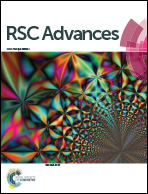New solution processed bulk-heterojunction organic solar cells based on a triazine-bridged porphyrin dyad as electron donor
Abstract
An unsymmetrical porphyrin dyad (ZnP)-[triazine-Npip]-(ZnPCOOH) or P-tNp-P′ consisting of two zinc-metallated porphyrin units covalently linked through their peripheral aryl-amino groups to a central triazine group, to which an N-piperidine group is also attached, has been used in combination with PC71BM ([6,6]-phenyl C71 butyric acid methyl ester) as electron donor and acceptor, respectively, for the active layer of solution-processed bulk hetero-junction (BHJ) organic solar cells. The photophysical properties of P-tNp-P′ and PC71BM blend films, as well as cyclic voltammetry measurements of the porphyrin dyad, suggest that P-tNp-P′ can effectively harvest photons and transfer electrons to PC71BM. The BHJ organic solar cell based on the P-tNp-P′ : PC71BM active layer blend in 1 : 1 weight ratio processed from THF resulted in a power conversion efficiency (PCE) of 2.91%. A significant improvement of the overall photovoltaic efficiency was achieved up to 4.16% when the active layer blend was processed from a 3% v/v mixture of pyridine in THF. This was ascribed to an enhancement of the short circuit current Jsc of the solar cell, which is related to the different surface morphology of the P-tNp-P′ : PC71BM active layer blend upon addition of pyridine. The pyridine-modified active layer exhibits a higher degree of crystallinity, as confirmed by the X-ray diffraction pattern and AFM images of the corresponding film, which results in an increase of exciton dissociation efficiency and more balanced charge transport.


 Please wait while we load your content...
Please wait while we load your content...